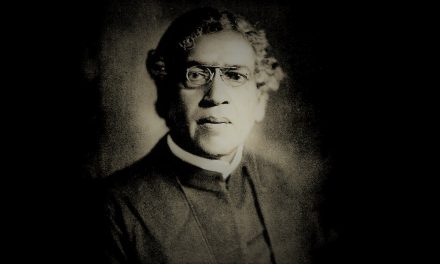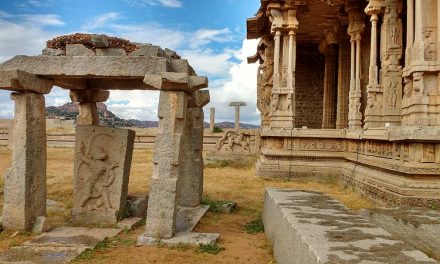A few days ago, a person who had commented on a tweet of mine a while back wrote in, saying that he supported Sati and felt it was a very `pure and sacred practice’. He said, and I quote, “Sati was a glorious practice. I admire the women who took part in it. Girls aren’t equal to guys, and the basic structure is different. People of tradition have skin in the game.” Reading these words made me stare at the screen for a good few moments, amazed, stunned, repelled, disgusted even. From my own Dharmic spiritual roots and meditations, I felt so distant from all that this person was speaking. Not only did he bring in regressive patriarchy into the picture but also spoke of realpolitik at the expense of the thousands and thousands of innocent girls who were sacrificed, unwillingly, might I add, for Dahatyaga with their husbands on the pyre in the nineteenth century. If the ultra-Left, anti-Hindu lot speaks of the regressive nature of Sanatana Dharma and I have this particular Dharmic ‘champion’ on my side, I will invariably be invalidating all the points that I see as truly Dharmic and possibly have to stand by the utter nonsense that some Adharmic Hindus spew these days! In recent centuries, the dynamics of identity has seeped into our collective psyche to such an extent that even Dharma, which is inherently a proverbial breaker-of-chains and seeks to spiritually emancipate all those who align with it, has acquired distortions introduced by the lack of a strong socio-political centre in the wake of foreign invasions, poor scholarship and the influence of selfish colonial powers. For instance, today some Hindus still stand by caste and Jaativad as if their life depended on it. How can one defend the apparently indefensible position that such people put one in, when faced with the allegations of Hinduism being oriented around a social, not spiritual, Varnavyavastha? I abhor such Adharmic Hindus, such conduct and such stances unequivocally. I have been tagged as an apologist', as someone who wants to conform to modern, liberal ideas and whitewash negatives of Sanatana Dharma‘, by both such individuals as well as those who have a passion for Hindu-bashing and cannot see such a progressive perspective on Dharma, which funnily is what the Dharmic truly purports to – the cosmopolitan, the pluralistic, the progressive. I am as far from being an apologist or whitewasher of regressive tendencies as any person can be, given my general proclivity to seeking truth (no matter what), my bluntness and my aversion to conform to `”fit in conveniently”. When someone can stand in one of the most Leftist bastions in the UK for years and can sustain his belief and ideas, not as a bystander but being prominently in the public eye, that should speak volumes of my consistency and courage when it comes to my ideas and principles.
I realise that Hindus have faced centuries of persecution and violence and continue to do so in Pakistan, Afghanistan and Bangladesh, along with the Hinduphobia that pervades the contemporary world in various places. But the Hindus themselves must rid themselves of interpolations, of baggages, of all that is not inherently Dharmic. The idea of Sati, for instance, has no scriptural or Dharmic mandate beyond a historical interpolation that went against what the Apaurusheya Vedas themselves said! The 8 verse in the 18th hymn of Mandala 10 of the Rig Veda says
उदीर्ष्व नार्यभि जीवलोकं गतासुमेतमुप शेष एहि|
हस्तग्राभस्य दिधिषोस्तवेदं पत्युर्जनित्वमभि सम्बभूथ||
Rise, come unto the world of life, O woman — come, he is lifeless by whose side thou liest. Wifehood with this thy husband was thy portion, who took thy hand and wooed thee as a lover.
Another Veda – the sacred Atharvaveda, composed around the first millennium BCE, speaks of a funerary ritual that is purely symbolic and not literal. In this ritual, the widow lies down by her deceased husband but is they asked to enjoy the blessings from the wealth and children left to her.
Professor David Brick of the University of Michigan, in the paper “The Dharmasastric Debate on Widow Burning“, writes
There is no mention of sahagamana (sati) whatsoever in either Vedic literature or any of the early Dharmasutras or Dharmasastras. By “early Dharmasutras or Dharmasastras”, I refer specifically to both the early Dharmasutras of Apastamba, Hiranyakesin, Gautama, Baudhayana and Vasistha, and the later Dharmasastras of Manu, Narada, and Yajnavalkya.
Professor Vidya Dehejia, Barbara Stoler Miller Professor of Indian and South Asian Art at Columbia University, concurs, stating that Vedic literature has no mention of any practice resembling Sati. There are no reliable historical records of any such practice before the time of the Gupta Empire. The lost works of Greek historian Aristobulus of Cassandreia, who travelled with Alexander the Great, speak of widow self-sacrifice, which is drawn into question since Megasthenes, on the other hand, does not mention anything about such a practice. According to Professor Anand A. Yang, former president of the World History Association, as written in his work “Whose Sati? Widow-Burning in early Nineteenth Century India”, one model for the spread of the idea of Sati is associated with the response of the warrior elite of India in the face of Muslim invasions of India, particularly how this became a means to preserve the honour of women whose husbands and/or partners had been slain. Ironically, Aurangzeb was said to have issued a proclamation to the effect of banning Sati in his kingdom, according to Sheikh Muhammad Ikram in his work “Muslim Civilization in India“, before it saw a resurgence in Bengal in the 19th century.
Daniel Grey, in his paper “Creating the ‘Problem Hindu’: Sati, Thuggee and Female Infanticide in India: 1800–60“, states that the understanding of the origins and spread of the Sati was distorted in the colonial era, as part of a concerted push to promote theories of the “problem Hindu” in the 19th and early twentieth centuries. If one were to closely read textual evidences, one can see that ancient Dharmic traditions and society may not have been as patriarchal or regressive as the colonial powers of the past and anti-Hindu lobbies today have tried to project them to be. Conversely, it saw women pioneers in varied areas, from philosophy and metaphysics to science and politics, such as Maitreyi, Gargi Vachaknavi, Lilavati, Khana and Prabhavatigupta. But the unfortunate truth is that we have certain Hindus today who display extreme levels of patriarchy and misogyny, in the name of `Dharmic’ constructs, such as dowry deaths and marital rape, girl child marriage, female infanticide and sister suicide pacts and yes, forced Sati, even today. This is so far away from the idea that those of us who truly believe in Dharma have to maintain extremely high standards of strongly standing against such regressive practices and realities in the contemporary world, simply due to the foundational ideas and tenets of Dharma.
Manusmriti, which is often referred to, to cite problematic ideas bordering on the regressive, when it comes to women and patriarchal constructs, is a Smriti – a text that does not hold the same authority or place as the Apaurusheya Sruti such as the Vedic verses. The Manusmriti is particularly problematic in that it has inconsistent arguments within it that are often diametrically opposite to others made within the text! At places, the Manusmriti talks of women as the mother of Creation itself and to be revered above the gods, while in other places it is really contemptible and repugnant about women. Given the positioning of any Smriti within the Dharmic fold, it is high time Hindus prioritise the word of the Vedas over a secondary text as the Manusmriti, as should those who accuse Dharma of being patriarchal and regressive when it comes to women. Verses in the Vedas themselves were said to have been revealed to women Rsikas, from Aditi, Aditirdakshayani, Juhurbramhajaya, Yami Vaivasvati, Ratrirbharadvaji, Vasukrapatni, Sashvatyangirasi, Shikhandinyava Psarasau Kashyapan and Suditirangirasah. In such a framework, speaking for regressive patriarchy would be as good as cutting at the very plinth of our way of life and its essence. The Rig Veda, in verses 1 to 3 in hymn 159 of Mandala 10, says
उदसौ सूर्यो अगादुदयं मामको भगः |
अहं तद्विद्वला पतिमभ्यसाक्षि विषासहिः ||
अहं केतुरहं मूर्धाहमुग्रा विवाचनी |
ममेदनुक्रतुं पतिः सेहानाया उपाचरेत ||
मम पुत्राः शत्रुहणो.अथो मे दुहिता विराट |
उताहमस्मि संजया पत्यौ मे शलोक उत्तमः ||
which means
The Sun has mounted up, and my happy fate has mounted high. I knowing this, as conqueror have won my husband for mine own. I am the banner and the head, a mighty arbitress am I: I am victorious, and my Lord shall stand by my will. My sons are slayers of the foe, my daughter is a ruling queen: I am victorious: o’er my Lord my song of triumph is supreme.
One can see the proactive and positive tone, triumphant even, of the women as she controls her life and enjoys the many blessings she actively creates instead of being handed them!
When it comes to the question of caste and how that does or does not conform to Dharma, I have previously written on my perspective on the same. I have stood for understanding Varna in a spiritual context, not as a social construct, and most definitely as not something one is born with. This stems from Varna‘s definition in terms of parts of Purusha in the Sankhya formalism. The important element that everyone conveniently forgets is that Purusha, in this context, refers to the spiritual, transcendent reality in the Universe. Prakriti, on the other hand, is the material, the physical energy pervading the Universe. Due to its very definition, Purusha is not associated with temporal or spatial ideas, nor of hierarchies and identities, since that which liberates, transcends, moves beyond the material and the worldly lies in the domain of Purusha. People often mistake the following verses from the Purusha Sukta (Hymn 90 of Mandala 10) of the Rig Veda
बराह्मणो.अस्य मुखमासीद बाहू राजन्यः कर्तः |
ऊरूतदस्य यद वैश्यः पद्भ्यां शूद्रो अजायत ||
, which translates to
The Brahman was his mouth, of both his arms was the Rajanya made. His thighs became the Vaisya, from his feet the Sudra was produced.
as the seed for social segregation, discrimination and casteism. As mentioned previously, we are not talking of the mouth and arms and thighs of a physical, material being here. We are talking of synergy between different manifestations of the spiritual, beyond and devoid of physical concepts of hierarchies and segregation. Purusha, by definition, is formless and beyond material modes or characterisations, as beautifully portrayed in the Srimad Bhagavad Gita (Chapter 11, Verse 38)
त्वमादिदेवः पुरुषः पुराण
स्त्वमस्य विश्वस्य परं निधानम्।
वेत्तासि वेद्यं च परं च धाम
त्वया ततं विश्वमनन्तरूप।।
Which translates to:
You are the original Purusha, the Godhead. You are the only sanctuary of this manifested cosmic world. You know everything, and You are all that is knowable. You are above the material modes. O limitless form! This whole cosmic manifestation is pervaded by You!
Many, and most specifically the Brahmins themselves, speak of their privilege, socially and historically. Given that this essay is on the very essence of Dharma, a natural question is: who is a Brahmin?
A Brahmin is not born one since great sages have been born in various castes, communities and from diverse origins such as Vyasa from a fisherman’s daughter. A Brahmin is surely not one due to his/her body or knowledge either since the body of all is made of the same elements and people from various castes and communities have had the knowledge to be regarded as spiritually and intellectually advanced, over various eons. A Brahmin cannot also be purely one due to his/her karma and deeds since even renowned Vedic seers have had momentary or even sustained lapses in past deeds, in certain anecdotes and references, thereby reducing the salvific efficacy of their accumulated good Karma. The word Brahmin comes from the root word Brā́hmaṇa. This, along with the word Brahman (which represents the ultimate reality of the Universe, in Vedanta), comes from the Sanskrit root term bṛh– “to swell, grow, expand, enlarge” which is a neuter noun. Brā́hmaṇa denotes a person associated with this idea of spiritual expansion and is therefore associated to Brahman itself. I regard Varna as the spectrum of spiritual attainments and the reality of the individual with respect to the Absolute Reality and the truth thereof. I strongly stand against any overt interpolation of classist or hierarchical ideas into this, even as I feel that Varna is defined not by birth but by one’s deeds, desire and actions to attain spiritual expansion. Any person, be it rich or poor, male or female, of any race or nationality, who has reached a point of dissolution into the transcendent oneness of reality itself, can be called a Brahmin under this framework, if one were to look at the root and essence of Dharma itself. In support of this argument, I would like to cite the following verses from the Mundaka Upanishad (Mundaka III Khanda 2 Verse 9):
स यो ह वै तत् परमं ब्रह्म वेद ब्रह्मैव भवति नास्याब्रह्मवित्कुले भवति।
तरति शोकं तरति पाप्मानं गुहाग्रन्थिभ्यो विमुक्तोऽमृतो भवति॥
which translates to
He who knows that highest Brahman becomes even Brahman; and in his line, none who knows not the Brahman will be born. He crosses grief and virtue and vice and being freed from the knot of the heart, becomes immortal.
This is a key Upanishadic support, besides the Vajrasuchi Upanishad, of my central argument: that a Brahmin is one who is aware of, and placed in the consciousness of and unity with, Brahman, the truest form of all things in the Universe. Looking at the entire idea and construct, from this perspective, the truth of the matter seems to be that Varnasrama refers to the stages of spiritual development and state rather than any social or political hierarchy. This system seems to have fallen prey to corruption, misprojection and misinterpretation over time, not any less driven by colonial powers and foreign invaders who accelerated the process of making Varnasrama become synonymous with Jaativad or casteism. We must stand against any and every Adharmic Hindu who speaks of the preeminence of Jaati and any associated elements of casteist segregation, discrimination or oppression. Any association of Varna with caste and Varnasrama with casteism cannot be further from the truth. It is time to reclaim Varnasrama. The true Varnasrama. A system that speaks of the social equality of all and appreciates the different spiritual attainments of individuals, helping orient them to higher levels of spirituality. Those who use caste and casteism, or discrimination based on other identities such as gender, for political reasons and pose as “champions of Hinduism” are the biggest enemies of true Dharma. In contemporary times, we see cases like that of a Dalit man being thrashed, stripped and paraded by dominant caste groups, even when undertaking a noble initiative like helping a 19-year old rape survivor file a police complaint. Muthu Mano, a Dalit leader and remand prisoner, was recently murdered by inmates at the Palayamkottai Central Prison due to caste enmity. There have been many instances of lower-caste youth being publiclly beaten and shamed, such as when an 18-year-old Dalit boy was thrashed in UP for opposing rash driving by ‘inebriated’ upper caste man. Even in reputed institutions like IIT Madras, recently an assistant professor spoke of facing multiple instances of caste discrimination, before quitting. This, just like in the case of misogyny and gender injustice, is fundamentally at variance with Dharma, at its most fundamental, and yet remains as a shameful reality propagated by certain Adharmic Hindus, in the name of `Dharmic constructs and ideas’.
There is, however, one other demon that has reared its head in the name of Dharma, courtesy certain Adharmic Hindus. Hatred. Hatred towards individuals primarily from various Abrahamic religions to the extent that they are dehumanised. Social media has become a new-age tool for hatred. Recently, in one Clubhouse room, a Muslim was offered Rs. 500 to chant ‘Jai Shri Ram’ 500 times. Such shallowness adversely affects the very cause they seem to be wanting to champion, with a lot of these pseudo-Dharmic voices wanting to create a hullabaloo around Dharmic elements that they possibly do not even align with beyond a point, atleast in essence if not in application. Why do I have a feeling that Sri Ram, had he himself been consulted, would most likely have abjured any association with such followers! On May 8, Swati Goel Sharma, a senior editor with Swarajya, hosted a space titled ‘Oximeters for cows?’, in which one of the speakers was Sanjeev Newar, whom Prime Minister Narendra Modi also follows. In this session, he said, “If you ask me, we should pressure the government that anyone who cracks a cow urine joke, the government should give us the freedom to beat them up in self defense. And it is no sin even if he dies because of the beating.” When I read about this, I was amazed by the level to which people prioritise an element of what I see as mock-propriety, that too for “cow urine jokes”, over and above the life and humanity of the people supposedly being regarded as needing this barbaric disciplining. Newar later on went on to clarify that he sought to speak for booking those who spread such jokes and had criminal tendences under the Indian Penal Code – a convenient glossing-over upon being cornered. Even on Koo, which is regarded as an Indian alternative to Twitter, this kind of hate is visible. Recently someone posted a poll asking followers to choose from certain denigrating labels for Muslims, while others have openly used slurs against Muslims. Regardless of how one assesses the teachings of Islam, demonizing an entire religion is unacceptable, especially for those aligned with inherently-pluralistic Dharma. For something that is based on the preeminence of truth, Dharma has lately had people aligned with it, who are peddlers of bizarre theories (such as when it was claimed that the transplantation of the elephant head of the god Ganesha, who embodies the Dharmic formulation of supreme consciousness, onto a human body was a great achievement of Indian surgery millennia ago) and fake news, including during the COVID pandemic! There have been other untruths spoken in the name of asserting the Hindu perspective, such as dismissing Darwin’s theory of evolution and claiming that cows inhale as well as exhale oxygen. Lately, the organization of the Kumbha Mela, even while a crisis of epic proportions was underway with COVID, was associated with misinformation and misalignment with the truth of how such an event could become a super-spreader, no matter how many precautions may have been taken. Many of the attendees did end up becoming COVID-positive. Dharma speaks of restraining oneself, in this case by not having less self-interest to be at variance with the truth. Rituals and Puja are important allegorical and operative elements of Dharmic traditions. However, we must at all times introspect and reflect on some of the points raised here (particularly in adopting an adaptive approach that promotes active cognizance of the reality to act accordingly, with the best interests of oneself and the world around) to reinforce the preeminence of truth for Dharma and seek to reduce hatred in our heart, if any.
The self-checks and balance that those aligned with Dharma (and here I do not mean a particular religion, as I have not in the rest of the article) must maintain has to have a very high standard, for what they represent or seemingly seek to, is a gem of mankind, a resource and premise that can usher in a better tomorrow. But only if those who stand for it, do not subvert and posit perverse interpretations of its nuances and essence! Given what is at stake today, in terms of world peace, sustainability, cosmopolitanism, pluralism and the very essence of what it means to be human, those straying, particularly the self-professed guardians and champions of Dharma, into Adharmic territory must be publicly called out as such. All those mob-lynchers and Dadas, those undertaking persecution and cruelty on others, are liabilities in the name of Dharma. Standing strongly for Dharma does not mean standing against others in such Adharmic ways. There can be no compromise on Dharma while standing for it! Sri Krishna is often stated as having mentioned that we must use realpolitik and pragmatism when required but even in those moments, where to take out evil one employs Adharma in a restricted manner, one must steer clear from unwise, unthought-of whims as well as wanton cruelty. He even went as an emissary to the Kaurava court in the epic Mahabharata as a last resort to avoid war, even when everyone on the Pandava side felt it would be a futile exercise. Dharma helps attain equilibrium in an ultimate reality that transcends all binaries, all dualities, all multiplicities. It liberates, it unites, it dissolves all manner of divisions. Unlike what a recent left-liberal critic mentioned, Dharma does not care about drawing everyone in with the aesthetics of the cultural and social, as an end in itself. The festivals, customs and rituals add a layer of allegory and symbolism to it, but Dharma is more fundamental, more primary than that. In fact, I would say that even if we were to rid Dharma of its historical and geocentric or even civilisational associations, it would remain unaffected. All religions and ideologies that stand for the inherent pluralism and cosmopolitanism of Dharma are fundamentally Dharmic. The word Dharma may have come from Sanskrit, and to make the playing field more universal, one can name it in myriad ways but it is the essence and not nomenclature that I personally stand for. Dharma is simply that which helps one attain one’s highest potentiality of being human, and yet transcend the limitations of the human condition.
All people belonging to any race or nationality can align with the idea of experiential progression towards the essence of nature, and the Universe itself is Dharmic. We have many individuals and groups in contemporary times, who wish to break the very fabric of society asunder, and all that Dharma stands for. Some terrorists kill for regressive, exclusivist ideas, and there are radical ideologues who condemn those who do not stand for their stances and beliefs as ever lesser than humans. In these times, Dharma can be the fundamental uniting and liberating premise, only if its own house is in order. Only if there are no Adharmic Hindus who try to chip away at its cause by positing perverted interpretations of its very essence and thereafter enacting regressive measures to stand by them, always remember, strength is never in regressive and aggressive perversions of one’s humanity, but in the assertive and surefooted stride to stand for one’s principles and life-values.
In peace and hope.
Banner: RANT 73, Digital Art
















